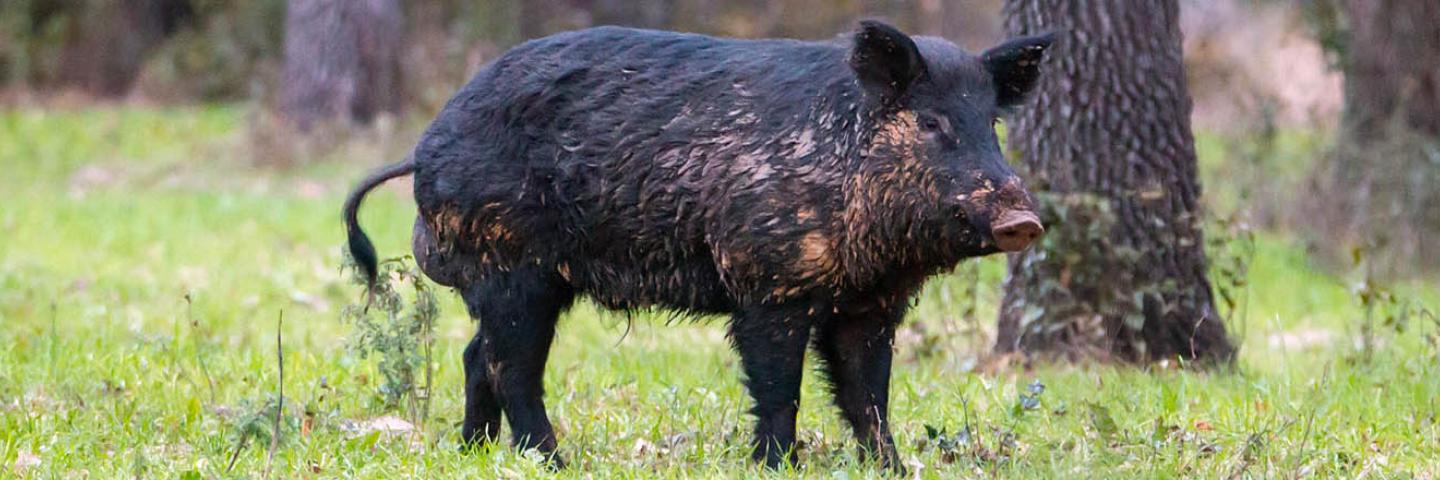USDA Partnership Delivers on Protecting Agricultural Resources, Native Ecosystems and Human and Animal Health, From Feral Swine Reinvasion

USDA unveils joint efforts to help ag producers & private landowners combat the costly impacts of feral swine.
It’s been five years since USDA launched the Feral Swine Eradication and Control Pilot Program (FSCP), which helps agricultural producers and private landowners combat the costly impacts of feral swine.
Through 34 pilot projects across 12 states highly impacted by feral hogs, USDA’s Natural Resources Conservation Service (NRCS) and Animal and Plant Health Inspection Services’ (APHIS) Wildlife Services (WS) partnered through the FSCP to control the threat of feral swine to agricultural landscapes and natural ecosystems.
Now, in its final year, the program has delivered on its goals of managing feral swine to reduce the damage caused to agriculture, property, natural resources, and human health, which is detailed in its newly released National Feral Swine Damage Assessment Preliminary Findings report.
The FSCP has worked for five years to help producers and landowners in Alabama, Arkansas, Florida, Georgia, Hawaii, Louisiana, Oklahoma, Mississippi, Missouri, North Carolina, South Carolina and Texas benefit from feral swine reductions. They can now expand the use of their agricultural lands, harvesting crops in areas that were previously devastated by feral swine and have reported being able to plant crops with higher economic returns.
Since last October, the program had successfully assisted over 4,300 landowners on almost 3 million acres. In addition, training and outreach events were held to educate landowners on feral swine issues and trapping techniques and reached more than 100,000 people across all pilot project areas.
The program also formed new partnerships and promoted projects and research that helped protect agricultural resources, native ecosystems, and human and animal health in areas hard hit by feral swine.
Working with 14 grant partners, NRCS provided financial assistance to producers for on-farm trapping and technology related to capturing and removing feral swine and restoring damaged lands. In addition, NRCS partner organizations provided other services, including pre- and post-project damage assessments and other means to assess control efforts.
Project delivery and conservation activities varied by state and local needs. For example, in Georgia, project delivery was based on watersheds and allowed the partners to monitor feral swine effects on water quality. Although preliminary results have shown improved water quality within the project area, additional monitoring will provide conclusive results soon. South Carolina project areas saw reduced average agricultural and environmental damage on participating properties.
APHIS worked through the program to continue direct control activities using well-established feral swine management methods and advanced innovative approaches to reduce feral hog populations, working with landowners to suppress and eliminate feral swine in project areas where agricultural and other natural resources were severely damaged.
Using innovative technologies such as unmanned aerial systems, remotely managed traps using telemetry, and science-based camera monitoring techniques, feral swine were eliminated in several areas and dramatically reduced in others. Due to this success, some landowners and resource managers who were previously skeptical about successfully managing feral swine damage, have changed their minds and now advocate for continued control efforts.
In addition, financial support from local partners has resulted in over $10 million in cost share support to APHIS WS activities in Farm Bill-funded states.
More Information
APHIS and NRCS worked jointly to develop guidance for identifying pilot project areas, based on several biological factors that contributed to successful operational control, including the presence of natural boundaries that limited rapid feral swine reinvasion from surrounding areas. In consultation with state technical committees, thirty-four pilot project areas were identified across 12 states.
The Feral Swine Eradication and Control Pilot Program (FSCP) was authorized by the 2018 Farm Bill and provided $75 million to be split evenly between NRCS and APHIS-WS, to reduce severe damage of feral swine, over a five-year span (2019-2023) .
For more information on this feral swine effort, visit the Feral Swine Eradication and Control Pilot Program web page.
Lacey Williamson is a natural resource specialist with NRCS, and she can be reached at lacey.williamson@usda.gov. Jeanine Neskey is an extension specialist with APHIS’ Wildlife Services, and she can be reached at jeanine.t.neskey@usda.gov.
Photos by Kegan Crouch, district conservationist with Texas NRCS.

